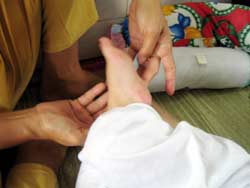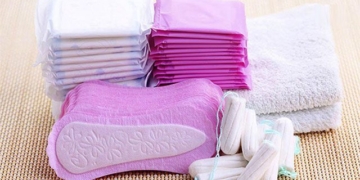Since the beginning of the year, Children’s Hospital 1 has received over 500 children under the age of 3 diagnosed with hand, foot, and mouth disease. Severe complications are primarily observed in children under 2 years old.
 |
| Blisters on the foot of a child being treated for hand, foot, and mouth disease at Children’s Hospital 1. |
On April 6, Dr. Truong Huu Khanh, head of the Infectious Diseases Department at Children’s Hospital 1, stated that children with hand, foot, and mouth disease who experience brain complications typically do not enter a deep coma but exhibit subtle neurological symptoms: difficulty sleeping, continuous crying, and startling during wakefulness or when beginning to doze off.
Children may show signs of panic, mumble incoherently, appear disoriented, tremble, or have seizures. Other symptoms indicating complications may include very high fever, frequent vomiting, a rash, rapid pulse without high fever, weakness in limbs, and facial drooping.
8 Days of Monitoring Hand, Foot, and Mouth Disease
As of the beginning of this year, the Infectious Diseases Department at Children’s Hospital 1 has treated over 500 children under 3 years old with hand, foot, and mouth disease, with severe complications primarily affecting those under 2 years old.
Previously, the disease was mainly caused by the relatively benign coxsackie virus. However, recent complications leading to encephalitis, myocarditis, and meningitis from hand, foot, and mouth disease are now attributed to a new, more dangerous agent, enterovirus 7.
Dr. Khanh also noted that the appearance of blisters is an early stage of hand, foot, and mouth disease and is not particularly concerning, as the complication rate is below 1%.
However, if a child develops complications and does not receive appropriate and timely treatment, they could die within hours.
| According to years of data from Children’s Hospital 1, hand, foot, and mouth disease typically occurs in two seasons: from February to April and again from September to December.
The symptoms of hand, foot, and mouth disease are easily recognizable, particularly the blisters. The blisters range in size from 2 to 10 mm, are gray, oval-shaped, and usually painless when pressed. Blisters can also appear in the mouth, and when they burst, they can cause ulcers. When blisters develop, children may experience a mild fever, irritability due to mouth pain, and a decreased appetite. Blisters generally subside on their own within 5 to 7 days. Some children may also experience vomiting and diarrhea when the blisters appear or after they have burst. |
To detect these complications early, it is crucial for parents to closely monitor their child for at least 8 days upon noticing symptoms of hand, foot, and mouth disease (such as blisters on the hands, feet, or mouth) to identify any suspicious signs of complications and seek medical attention.
Additionally, if any unusual mild neurological symptoms or blisters are observed on the palms, soles, knees, or buttocks of the child, they should be taken to the hospital immediately.
In cases without complications, treatment can be managed at home with pain relief medication and soft, easily digestible foods. Parents should aim to feed the child multiple small meals.
Source of Infection: From Adult Hands
Currently, there is no vaccine for enterovirus 71, so the primary prevention method is to ensure proper hygiene during meals.
This disease is commonly found in young children under 5 years old and is highly contagious, often spreading quickly through the digestive tract, particularly among children living in the same household or attending the same daycare. It is advisable to keep children home from school or avoid contact with sick children when in the same house, as the disease spreads easily from one child to another through direct contact.
According to Dr. Khanh, to limit the spread of this disease during the current outbreak, the most important measure is for adults to wash their hands thoroughly.
“When feeding children, playing with toys, changing diapers, cleaning feces or urine, or caring for them… if hands are not washed, adult hands can easily become a source of infection when touching another child,” warns Dr. Khanh.
Huong Cat



















































